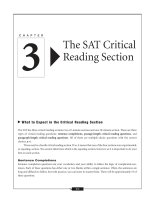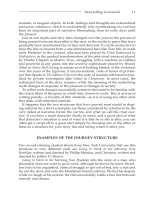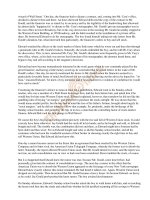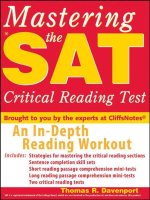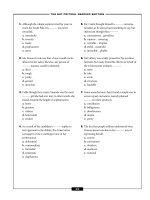The sat critical reading section 4 doc
Bạn đang xem bản rút gọn của tài liệu. Xem và tải ngay bản đầy đủ của tài liệu tại đây (80.63 KB, 6 trang )
Part 2: Reading Is Critical
There are approximately 40 long-passage critical read-
ing questions on the SAT. Each Critical Reading sec-
tion contains at least one long passage, followed by
questions about the passage. Passages are excerpted
from writings in the fields of literature, humanities,
and social and natural sciences. There is no poetry.
Each passage is between 400 and 850 words in length,
and there will be between 5 and 13 questions after
each one.
In one critical reading section of the exam, there
will be a set of two long passages. These two passages
will complement each other in some way. Most often,
they will present either supporting or opposing points
of view. Some of the questions about these passages will
require that you be able to analyze similarities and dif-
ferences between the two passages.
Many of the reading comprehension questions
are vocabulary-related. You can think of them as a vari-
ation on sentence completion questions, asking you
to determine the meaning of a word or phrase in con-
text. Sometimes, the test-makers ask about fairly com-
mon words that have multiple uses and ask you to
choose the correct meaning or shade of meaning. Most
often, the answer will be a more obscure meaning of the
commonly used word.
Other reading comprehension questions test your
ability to understand what you read. SAT passages are
usually complex, densely packed with ideas; and many
are somewhat overwhelming at first glance. You will be
asked to extract information that may be stated explic-
itly or implied. In other words, a passage may contain
arguments with underlying assumptions, which you
will be asked to uncover. You will be asked about the
logical flow of the texts and about their consistency or
lack thereof. You may also have to answer questions
about the tone of the passages as well as their overall
theme or meaning.
Fortunately, the skills you are learning for the
sentence completion questions will also serve you well
for the reading comprehension questions. Additionally,
learning to make sense of complex passages will make
your college career even more successful.
Ready, Set, Read!
If you are already skilled at quickly reading and under-
standing dense prose, good for you! If not, try this
approach. Feel free to adapt it and change it to suit your
needs and temperament. There’s no one “right” way to
read. The right way to do all of these things is the way
that works for you; so as you practice, try variations on
the method to see what suits you.
Every reading comprehension passage has a short
one- to three-sentence introduction. This introduc-
tion will provide you with some context for the passage
as a whole, so read it first. Occasionally, there will be a
question that requires knowledge of this introduction,
so read it carefully.
Now you may want to skim the passage for its
subject matter. With practice, you will find that topic
sentences and key adjectives will practically leap out
and grab your attention. Be sure to keep your pencil
poised to write as you read. You will want to mark key
words and phrases as you see them.
Next, read the passage all the way through. As you
finish each paragraph, determine its main idea. Then,
jot a word or phrase that expresses that idea in the
margin of your test booklet. This is a note to yourself,
which will enable you to easily find sections of the pas-
sage later and quickly tie the separate paragraphs into
a coherent whole.
As you read the passage, mark any words or
phrases that seem particularly important or expres-
sive. Often, adjectives that set a mood or tone will help
you understand the author’s meaning, so underline
them or jot them down in the margin. It’s also impor-
tant to note the location of details that support the
author’s main point(s).
Of course, you were paying attention in English
class when the teacher discussed topic sentences, so
you know that most well-written paragraphs have at
–THE SAT CRITICAL READING SECTION–
57
5658 SAT2006[03](fin).qx 11/21/05 6:42 PM Page 57
least one sentence that sums up the main thrust of the
paragraph. It is most often either the first or the last
sentence, so if you’re having trouble determining the
author’s point, reread the first and last sentences of
each paragraph.
Once you’ve quickly but carefully read the entire
passage, it’s time to tackle the questions. On the SAT,
the questions are organized roughly in the same order
as the parts of the passage to which they refer. In other
words, the answer to the second question will most
likely be found in the passage somewhere after the
answer to the first question, and so forth. All of the pas-
sages on the SAT are numbered every five lines. Addi-
tionally, many of the questions contain the line number
or numbers that will help you locate the answer.
Beware, though, that you don’t assume that the answer
to the question will be found exactly in the line refer-
enced in the question. Chances are, it will be found
somewhere near that line; but it still may be a few lines
away. This is when the words and phrases you have
marked and the notes you have jotted in the margin will
come in really handy.
When you have a set of questions on two related
passages, there will be several questions without line
numbers. Those questions will usually ask you to com-
pare the two passages in various ways. Again, you will
be glad for your marks and notes on the passages.
As you read each question, approach it as you
would any other sentence. Underline or circle key
words and phrases that help you with the meaning of
the question. Whenever you see a word or phrase such
as best, primarily, most closely, or most nearly, it alerts
you to the likely presence of particularly good dis-
tracter answers. That is to say, there may be two or
more answers that reflect language from the passage or
that may be true about the passage. Rest assured, how-
ever, that with careful attention to the wording of both
question and answer choices, you can determine which
choice is truly best.
Nine Proven Strategies for
Reading Comprehension
Questions
1. Read actively! As you read, ask yourself at the end
of each paragraph what it was about. Mark up the
passage, and write any thoughts you have about it
in the margins. Be an engaged reader. Try to
become interested for a few minutes in whatever
the subject of the passage is.
2. If you have an especially good short-term mem-
ory, you may want to look at the questions before
you read the passage. Mark the words and
phrases the questions ask about, then look for
those words and phrases in the passage. When
you find them, you can either go ahead and
answer the question right then or mark the area
to come back to later.
3. If you don’t understand what a question is ask-
ing, rephrase the question, using your own
words. SAT questions are written in a very pre-
cise, “hyper-grammatical” style to eliminate any
ambiguity. Unfortunately, nobody talks that way,
so the questions can be confusing at first glance.
Once you have marked the key words and
phrases, rearrange them in a way that makes
sense to you. Don’t be afraid to add new words to
the question; just be sure the words are express-
ing the same ideas that are already in the ques-
tion and not changing the meaning of the
question in any way.
4. Once you understand a question, try to answer it
in your own words before looking at the answer
choices. Distracter answer choices often take one
of several forms:
■
are close to the correct answer, but wrong in
some detail
■
are true, but do not answer the question
■
use language found in the text, but do not
answer the question correctly
–THE SAT CRITICAL READING SECTION–
58
5658 SAT2006[03](fin).qx 11/21/05 6:42 PM Page 58
5. As with all the multiple-choice questions on the
SAT, elimination is an important strategy for the
reading comprehension questions. Even if you
don’t know the answer to a particular question
right away, you often will be able to eliminate
one to three answer choices without even refer-
ring back to the passage. Then you know that one
of the remaining answers is the correct one, and
you can spend your time more productively
looking up those answers in the passage.
6. If you know from your preparation and pretest-
ing that you don’t always have enough time to
finish each section, don’t hesitate to skip around
the questions. Look them over and answer the
easy ones first, coming back to the more difficult
questions. Remember, each correct answer is
worth one point. You don’t get bonus points for
answering more difficult questions. If you skip a
question, though, mark it in your test booklet
and come back to it if there’s time.
7. When you encounter a two-passage section, read
the passages with their relationship in mind. Are
they in agreement? Are they opposed? Is there
some other kind of relationship? How would you
describe the relationship? If the passages are
opposed, what are the points of difference? Jot
these things down and refer back to them, if
necessary.
8. Expect to refer back to the passages(s) on virtu-
ally every question. If you know the answer to a
question without referring to the passage, fine;
however, it might be a good idea to check the
passage anyway, just to make sure you haven’t
fallen for a distracter answer.
9. Remember to read between the lines! You may
remember that you must be extremely literal
with sentence completion questions and never
read anything into them or bring in any ideas
that are not clearly expressed within the sentence
itself. That’s not true with critical reading ques-
tions. In fact, you will be called upon to interpret
almost every passage, to draw conclusions from
the text, and to extend the author’s point of view
to evaluate a statement that isn’t even in the pas-
sage. That’s why it is so important to be actively
engaged in reading each passage. Try to under-
stand it as though you had written it yourself.
–THE SAT CRITICAL READING SECTION–
59
5658 SAT2006[03](fin).qx 11/21/05 6:42 PM Page 59
5658 SAT2006[03](fin).qx 11/21/05 6:42 PM Page 60
–LEARNINGEXPRESS ANSWER SHEET–
61
1.abcde
2.abcde
3.abcde
4.abcde
5.abcde
6.abcde
7.abcde
8.abcde
9.abcde
10.abcde
11.abcde
12.abcde
13.abcde
14.abcde
15.abcde
16.abcde
17.abcde
18.abcde
19.abcde
20.abcde
21.abcde
22.abcde
23.abcde
24.abcde
25.abcde
26.abcde
27.abcde
28.abcde
29.abcde
30.abcde
31.abcde
32.abcde
33.abcde
34.abcde
35.abcde
36.abcde
37.abcde
38.abcde
39.abcde
40.abcde
40 Practice Long-Passage Critical Reading Questions
Read the passage and the questions that follow it. As you form your answers, be sure to base them on what is stated
in the passage and introduction, or the inferences you can make from the material.
Use the answer sheet below to record your answers.
ANSWER SHEET
5658 SAT2006[03](fin).qx 11/21/05 6:42 PM Page 61
5658 SAT2006[03](fin).qx 11/21/05 6:42 PM Page 62

